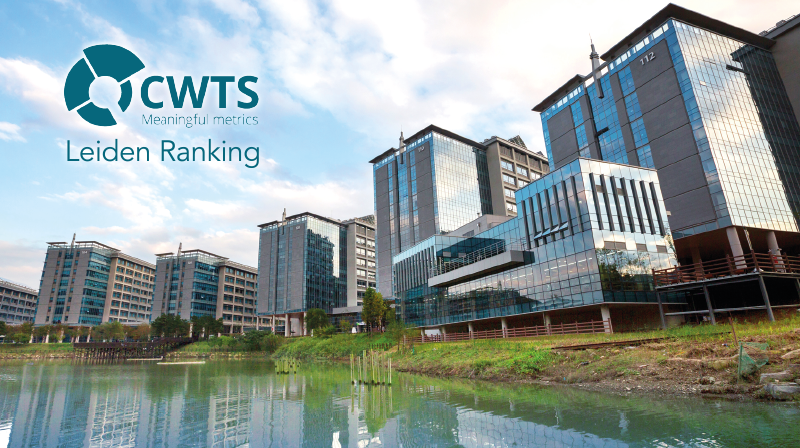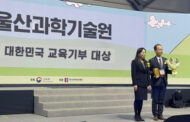UNIST has maintained its position as the top university in South Korea for the fourth successive year, according to the CWTS Leiden Ranking 2020 that weighs how many of an institution’s scientific publications are widely cited by other scientists. The ranking puts UNIST in the top spot among S. Korean universities, and 99th place globally.
Released on July 8, the 2020 edition of Leiden Ranking judged the top 1, 176 universities from 65 countries. These universities are the ones that have produced at least 800 Web of Science indexed publications in the period 2015–2018. The Leiden group found that 13.9% of UNIST publications were among the top 10% most widely cited of all scientific publications during the time period studied, 2015 to 2018. Besides, the ranking also reported that about 1.4% of UNIST’s publications during that period belong to the top 1% of highly cited papers.
The top five highest-ranked universities overall (based on the proportion of publications that belong to the top 10 % most cited) are Rockefeller University (33.3%), the Massachusetts Institute of Technology (24.5%), Princeton University (23.6%), Stanford University (22.2%), and Harvard University (21.6%), all USA.
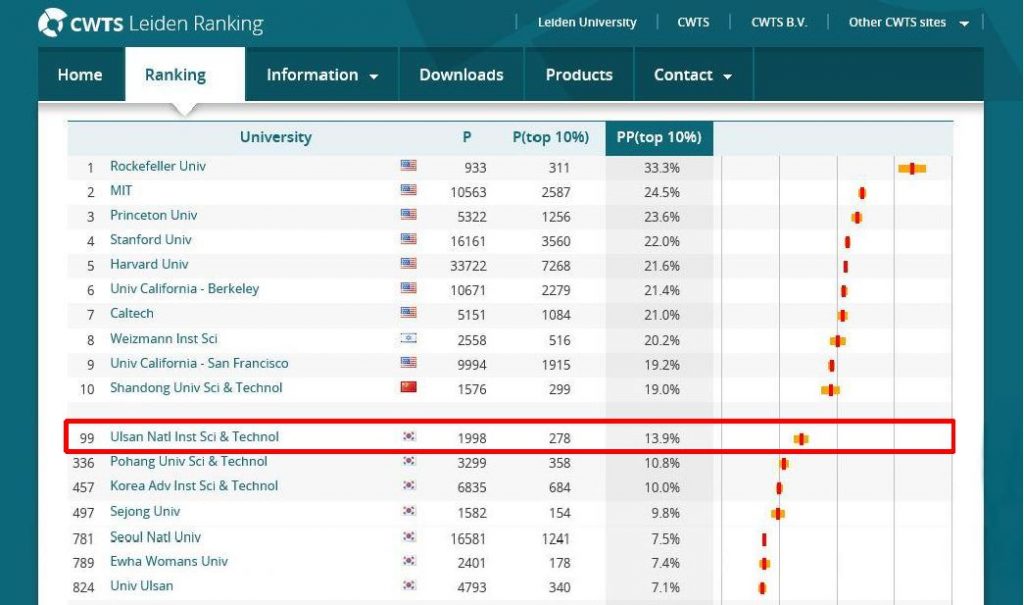
2020 CWTS Leiden Ranking (Worldwide): 99th Place, 13.9% (Proportion of Top 10% Most Frequently Cited Publications, Using Fractional Counting) l Source: CWTS Leiden Ranking
Note: The fractional counting method leads to a more proper field normalization of scientific impact indicators and therefore to fairer comparisons between universities active in different fields. For this reason, fractional counting is the preferred counting method for the scientific impact indicators in the Leiden Ranking.
The CWTS Leiden Ranking for 2020 has been published by the Centre for Science and Technology Studies at Leiden University in the Netherlands and is based entirely on data provided by the Web of Science now run by Clarivate Analytics. It provides a rating that is based on the absolute number of top-cited publications (which is size-dependent), as well as a size-independent list, where the performance of a university’s publications is measured relative to its publication output.
During the period of assessment, UNIST produced a total of 1,998 papers — the bulk of which was in the physical science and engineering. UNIST published the most highly cited papers (278 papers) relative to its size in the following citation metrics on offer — the top 10% and 1%. About 13.9% of UNIST’s contribution was in the top 10% of highly cited papers, thereby retaining its position as S. Korea’s top university. This result was based on fractional counting and it was higher than those of POSTECH (10.8%), KAIST (10.0%), Sejong University (9.8%), Seoul National Univesity (7.5%), Ewha Womans University (7.4%), and the University of Ulsan (7.1%).
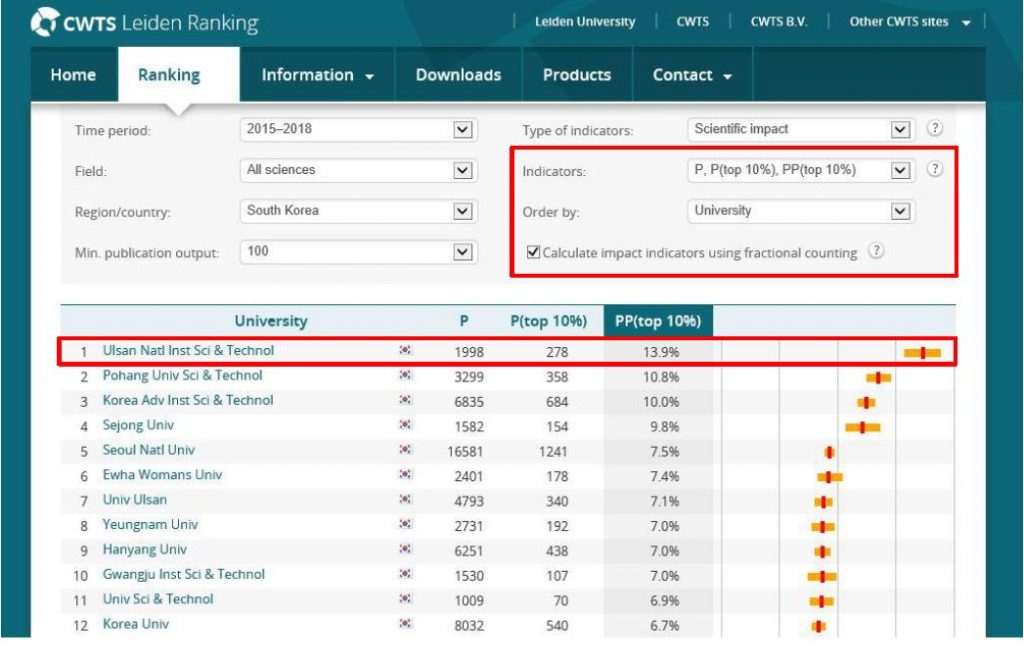
2020 CWTS Leiden Ranking (Nationwide): No. 1 Place, 13.9% (Proportion of Top 10% Most Frequently Cited Publications, Using Fractional Counting) l Source: CWTS Leiden Ranking
Note: The fractional counting method leads to a more proper field normalization of scientific impact indicators and therefore to fairer comparisons between universities active in different fields. For this reason, fractional counting is the preferred counting method for the scientific impact indicators in the Leiden Ranking.
UNIST was also ranked first when measuring the proportion of publications in the Top 1%. This is well ahead of the second-place institution, Yeungnam University, for which the figure is 1.0%. Sejong University, KAIST, and Kwangwoon University rounded out the top five.
As shown in the table below, about 1.4% of UNIST’s publications between 2015 and 2018, belong to the top 1% of highly cited papers. This again gives UNIST a reputation of being the highest-ranked Korean institution in this category.
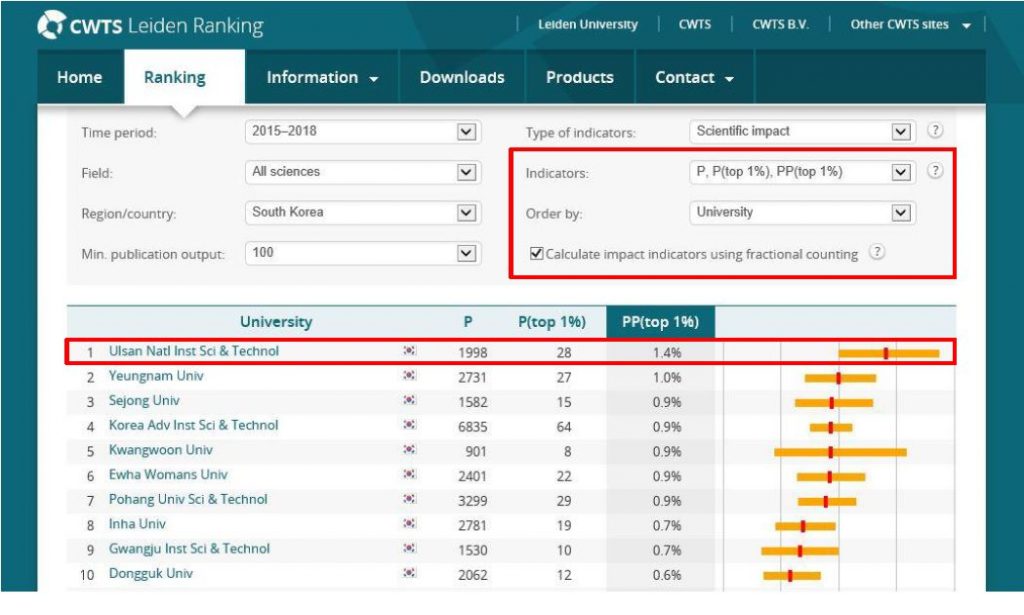
2020 CWTS Leiden Ranking (Nationwide): No.1 Place, 1, 1.4% (Proportion of Top 1% Most Frequently Cited Publications, Using Fractional Counting) l Source: CWTS Leiden Ranking
Note: The fractional counting method leads to a more proper field normalization of scientific impact indicators and therefore to fairer comparisons between universities active in different fields. For this reason, fractional counting is the preferred counting method for the scientific impact indicators in the Leiden Ranking.
“This result is largely due to your selfless contributions—from outstanding research to the commitment towards education,” says President Yong Hoon Lee. “UNIST will create an outstanding research environment where researchers strive for and achieve.”


